
In this month’s Between the Bookends, Corrina takes an eye-opening look at disaster preparedness in the United States, Anika revisits a teenage favorite to see if the story has withstood the test of time, Rebecca is happy to have allowed one more book into her teetering to-read pile, Amy indulges in a spot of bibliotherapy with her daughter, Sophie explores the history of board games, and Bookends newcomer Chris shows us three very different takes on the near-future, some better than others.
We hope you find something to see you through these final weeks of summer. That’s assuming your kids haven’t already sent you to the bottom of a wine bottle or ten. Happy reading!
![]()
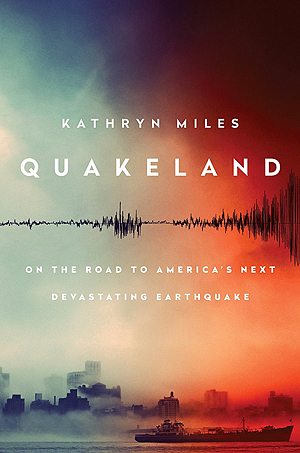
Quakeland by Kathryn Miles
When Corrina was speaking to the Penguin Random House representative at Book Expo America about possible books to review and the marketing person mentioned Quakeland, she jumped at the chance. It’s not that she loves natural disasters, per se, but she loves the science behind them.
While the ice cream book Corrina read last month was more a personal story about the author’s relationship with the sweet dessert, Quakeland looks outward. Miles is a terrific writer, adding bits of humor and even dry wit to some truly horrifying scenarios. Especially because the science of earthquake prediction is, right now, inexact. Some scientists even want to create small ones, just for study purposes, which leads to this terrific passage in the book:
“That’s why Heather Savage would really like to trigger one of her own. She’s not unreasonable: she says she could do it in a remote place, maybe part of Nevada owned by the Bureau of Land Management. And she’ll be content with an M 4.0 or so (though some of her peers are pushing her to try for an M 6.0). She hasn’t petitioned the government yet. But she’d like to. She hopes you don’t mind.”
If you noticed the “M” above in reference to measuring earthquakes instead of the more commonly used Richter scale, that’s on purpose. One of the first things you learn in this book is that only the public uses the Richter scale, not scientists. M, for magnitude, is what they use, and each increase in the scale is exponential.
Miles takes readers through the history of earthquakes, their possible causes, the different types, how the human reaction to them has changed over time, and what we’re doing to prepare for them right now. Hint: FedEx has done a ton of earthquake and natural disaster preparation at their Memphis hub. That might be a good place to go in case of a zombie apocalypse. Miles also covers earthquakes and their connection to the practice known as fracking. But it’s not fracking that is the single culprit in man-made earthquakes. High-velocity water-injection may be exposing us to dangers that might not become apparent for years.
By the end of the book, Corrina was convinced that she needs a Go Bag, the term for the case/bag/trunk stuffed with disaster preparedness supplies. Because if you think you’re in a safe area of the country, Miles points out that you’re likely not. It’s a lively and fascinating book but Corrina found it also one that points out just how unprepared most cities and nations are for a quake, even one relatively low on the Magnitude scale.
![]()
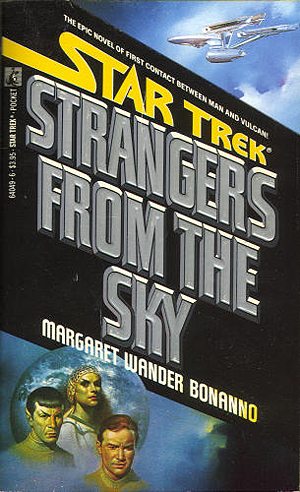
Strangers from the Sky by Margaret Wander Bonanno
Anika first read Strangers from the Sky by Margaret Wander Bonanno when she was twelve or thirteen and in the first throes of what has proven to be a lifelong love of all things Star Trek. She remembered it fondly for years, re-read it a couple times, and even suggested it to other fans in a discussion of the Women at Warp Podcast Episode “How I Met Your Great-Great Grandmother” (which details an episode of Enterprise that shares many story elements with the book). The recommendation was recently brought up by another listener and Anika decided to revisit the book, to see if it held up, and what adult Anika might find that tween Anika didn’t notice.
Two things stood out this time around. The first is the absolutely terrible representation of mental health professionals in Starfleet. Which, honestly, unfortunately, skews true to canon. It’s commendable that a mental health division exists in the Star Trek future, but the series has never quite gotten a handle on how to use or present it. This book requires a content warning for abuse institutional care: Admiral Kirk is literally dragged from a beach by Starfleet Medical Personnel (including his bestie McCoy) and then held and medicated against his will in a psychiatric institution. And then they make fun of Vulcan culture and medicine and it is all just, pretty terrible.
Second, they also comment on quite a few human cultures and it’s not exactly problematic but it’s notable that the best and brightest of the characters in the “past” is an old white cis man from Boston. All the protagonists and support characters are also white, unless they are Vulcan, while the antagonist (though not a villain) is a Thebian meddler. There are also terrorists but that side plot is so boring I didn’t read it when I was twelve and I felt my eyes roll back every time it came up this time around.
But that said, it’s an enjoyable story, kind of a historic fiction heist that stars Kirk and Spock. The Vulcans are the most interesting characters, likely because the humans are somehow both outdated (the book is set in the near future but written in the near past and it shows) and too close to current reality (yikes!). It flies against canon as of the Next Generation film, First Contact, but if you can let that go, and get past the two points above, it’s a fun read for fans of the Original Series.
![]()
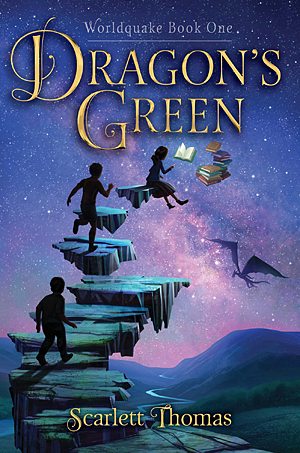
Dragon’s Green by Scarlett Thomas
Rebecca Angel has so many books to read. Really, it can get despairing looking at the pile (physical heap in the basement, online Goodreads list, “to read” notes on her phone…) so when she was contacted about checking out a new middle-grade fantasy book called Dragon’s Green, Rebecca was about to type a hasty “no way!” But the title intrigued her, and the blurb mentioned it was set in a dystopian future where the technology is set back, “something like 1992”. Hmm… Rebecca’s high school years. She asked for a copy and is thrilled to recommend this new series by Scarlett Thomas.
Our heroine is Effie Truelove, a lonely eleven-year old whose mother recently disappeared, not-coincidentally at the same time the entire world suffered the Worldquake: a literal shaking of the earth that afterward left technology and the modern world ineffective or unreliable. Effie’s once-loving father remarried and Effie is not welcome into his new life. For the past year, she has been with her distant and eccentric grandfather Griffin, in a house filled with books, wonders, and magic she is not allowed to believe in.
But she does believe in magic, as does her grandfather, who only just starts to teach Effie when he is struck down, leaving Effie with clues, items, and ownership to his vast and powerful library. Unfortunately, there are people in the magical and non-magical world that take it all away. Effie begins on an adventure to recover what is rightly hers, but she can’t do it alone. She stumbles across other children who want to help, and they all become friends along the way: Maximilian, Wolf, Lexy, and Raven.
Although Thomas’ world building is very well done, the plot moves along just right, and the writing is clear but not dumbed-down, it’s the characters that make this novel stand out. The kids are real kids: unsure but sincere. Maximilian is a complicated one who it will be intriguing to watch mature, Wolf’s story made her tear up at the end, Raven is so cool, Lexy captured her heart (the letter to magic!), and Effie is intelligent, brave, and compassionate- a true hero.
When Rebecca finished the book, she had that yearning that only comes from a very good book: that the world was real, and she could be part of that wonderful group of characters. Unfortunately, she will have to be satisfied with reading about it all. She invites you (and your children middle-grade and up) along on the ride in this new series.
![]()
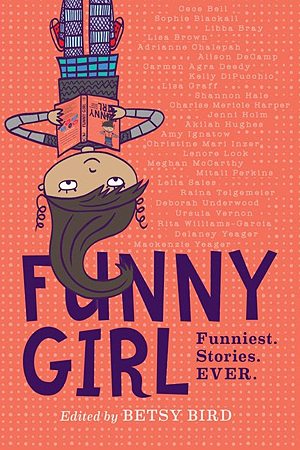
Funny Girl: Funniest. Stories. Ever. by Betsy Bird
Amy recently brought home two books specifically for her eight-year-old daughter that everyone enjoyed. The first is a collection of short stories edited by Amy’s favorite librarian-blogger Betsy Bird, Funny Girl: Funniest. Stories. EVER. The collection is designed to dispel the myth that girls aren’t funny by collecting stories from some of the funniest ladies writing today, whether fiction, memoir, picture books, or TV.
Amy’s daughter is an ideal audience because she is a very funny girl, but, with the possible exception of Libba Bray’s “Public Service Announcement About Your Period from Sarah T. Wrigley, Age 12 3/4” the stories are definitely for all audiences of any age or gender, not just funny girls. Even that one could be appreciated by a boy with enough opposite-sex background knowledge, as it includes plenty of good unisex tips like, “don’t use tampons as building blocks then spill your breakfast on it.” Despite Libba Bray definitely being one of the funniest writers Amy knows, male or female, the girl, her 10-year-old brother, and Amy all agree that the absolute funniest story in the collection is Allison DeCamp’s “Dear Grandpa: Give Me Money,” but Amy’s personal favorite is Carmen Agra Deedy’s memoir of exploding bathtubs, “One Hot Mess,” which manages to be heartrending and hysterical at the same time.
As is the fate of most anthologies, the stories do vary in quality, but on the more fun side, they also vary in format and genre, with comics, epistolary stories, nonfiction advice pieces, animal stories, school stories, and lots of memoirs included. All come from funny ladies both little-known and popular such as Raina Telgemeier, Ursula Vernon, Jenni Holm, and Shannon Hale, who also wrote the other book Amy gave to her daughter this month.
![]()

Real Friends by Shannon Hale and LeUyen Pham
After the incident at the school picnic, Amy thought she might slip her daughter a subtle bit of bibliotherapy that she’d enjoy too much to notice it was bibliotherapy. After all, it comes from Hale and LeUyen Pham, the talent behind The Princess in Black, and it’s in graphic novel format, which she also loves. But it’s not a novel, it’s a memoir of Hale’s childhood friendships.
In Real Friends, the ups and downs of the elementary-school social scene are rendered with excruciating accuracy that anyone who is and was ever a kid will recognize all too well. How do you navigate between friends and “friends” and those times when the same people seem to be both? The memoir aspect in the voice adds a layer of hope to the struggle: this grown-up obviously GETS it, but she also survived and gained genuine friends in the end–it will all work out!
Even though the book deals with the worst aspects of childhood, it does so with humor, both cringe-humor (Hale has no problem showing young Shannon making embarrassing mistakes) and lighthearted fun, especially through young Shannon’s wild flights of make-believe, exuberantly brought to life in Pham’s illustrations. When the book arrived, the eight-year-old grabbed it out of Amy’s hands, disappeared for an hour, then returned with it clutched to her chest, saying, “This is mine, now.” Amy didn’t bother to tell her that was the point.
![]()

All Rights Reserved by Gregory Scott Katsoulis
Chris has been eager for the release of first-time author Gregory Scott Katsoulis’ young adult novel All Rights Reserved. The excitement began in February when GeekDad was given the opportunity for an exclusive cover reveal and continued in May when Chris shared his thoughts on an advance reader copy of the novel on the GeekDad Podcast Network show We Are Entertained. After all of this pre-release excitement, Chris is happy to share that the book is finally being released this month.
Katsoulis paints a picture of a world that is one part 1984, one part The Hunger Games, and one part Minority Report. The subject matter couldn’t be more timely, in this world copyright and intellectual property law has progressed to a point where not only every word but every emotional reaction is subject to royalty payments. With the rise of dystopian worlds in young adult fiction it’s refreshing to find a standout like All Rights Reserved, not only does it convey the horror of unaffordable utterances but it does so in a way that is utterly relatable and is sure to make readers think.
Parents should be cautious with this book with younger readers, however. It’s not giving anything away to say that the story begins with a character dying by suicide. There are some dark and violent corners in the world of this book and Katsoulis doesn’t shy away from exposing his readers to them. It’s all tastefully done but it may be quite an emotional road for some. It’s a good enough book that parents will enjoy it thoroughly so there’s no reason not to pre-read it if you’re at all concerned.
![]()

The God Peak by Patrick Hemstreet
One of the great joys in life is discovering a great new author completely by accident. Chris received an advance copy of Patrick Hemstreet’s new book The God Peak in the mail and tossed it on the “get around to” stack. On a whim, several days later, he picked it up and scanned a few pages in the middle to get a taste of what he had in store for him. Disaster! It was fantastic and it was the second book in a series! To cut to the chase, an immediate download of The God Wave occurred and two days later Chris was on to The God Peak.
A little bit about the series; a group of neuroscientists makes some startling discoveries while poking around in the brains of talented subjects. With the help of a mathematical genius from MIT, they puzzle out a method for controlling machinery directly with the mind. They are shocked as breakthrough after breakthrough propels their research beyond anything they had ever dreamed possible.
The first book covers the formation of the group’s business venture, Forward Kinetics, and their eventual showdown with a paramilitary group that has dastardly designs on the group’s telekinesis inducing tech. The book ends after a grand boss-battle that reveals just how powerful the heroes of Forward Kinetics have become. The sequel picks up the story right where the first novel leaves off. The neuroscientists-turned-superheroes have teamed up with a mysterious group called the Benefactors in an effort to stop a group of their former colleagues who have gone rogue and are holding the world’s militaries hostage.
Hemstreet does a great job of making this feel like it could all be happening just down the street from the reader. Timely references make the story seem frighteningly relevant and cause the reader to think deeply about the current state of the world while still enveloping them in fantasy. There are reviewers who caution the reader about intimidating levels of scientific detail in both books but geeky readers with a solid grasp of basic science should have no problems.
![]()
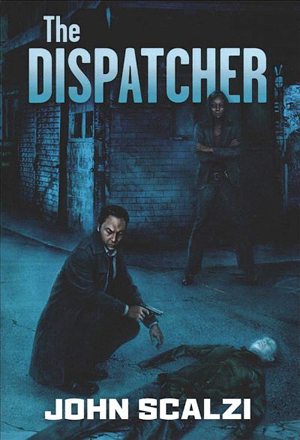
The Dispatcher by John Scalzi
Chris is an avid listener of audiobooks and this month has two selections that are standouts for very different reasons. First is The Dispatcher by John Scalzi, a work that turned the normal publishing cycle upside down when it dropped first on Audible followed months later as a printed novella.
The audio performance is handled exquisitely by Zachary Quinto and may very well have been a deciding factor in leading with a release on Audible. This is a short read and quite different from what most Scalzi fans will be expecting. This isn’t a space opera and there isn’t a military transport in sight, what we’ve got in The Dispatcher is a detective story set in the near future with one relatively minor yet utterly world altering twist. Everyone who is murdered comes back to life. Well, almost everyone comes back, we’re told that 999 out of every 1000 murders results in the victim reappearing naked in their bed, safe and sound and little worse for the wear.
What makes this book fabulous is the way that Scalzi explores, often so subtly that you’re likely to miss it if you’re not paying attention, the ways that this simple permutation changes society. How different can the world be from the one we know if we tweak one small parameter. This is a rare recommendation but the Audible production is definitely the way to go with this book. The text reads a bit like a screenplay and is heavy on dialog; Quinto’s performance brings the story to life in a way that should put this one in everyone’s must-listen queue.
![]()

Terminal Event by Robert Vaughan
The second audiobook in the list stands out for a very different reason. Chris often puts faith in Amazon’s recommendation engine and rarely hesitates to try a book that comes in highly rated. This month, with a stack of Audible credits piling up, he took a chance on Terminal Event by Robert Vaughan. In this book, readers learn of the discovery of a golden cylinder deep under the ice in Antarctica. A group of scientists open the cylinder (which, curiously, has a childproof medicine lid) and discover six human embryos. Science happens and the hundred million-year-old embryos are brought to term and begin to tell a fantastic tale of ancient Earth and the creation of the Moon. Yep.
This book was published back in June but is new to Audible as of August so there weren’t many reviews to warn potential readers about the many wrong turns that Vaughan takes in this mess of a story. Moving beyond the numerous plot holes, ludicrous pseudo-science, weak characters, and vapid dialog, potential listeners to the audio version are subjected to a poor performance by narrator Wally Schrass and far too many audio glitches. This is the first book that has ever caused Chris to take advantage of the “Great Listen Guarantee” and return for full credit. Needless to say, this one does not get a strong recommendation.
![]()

It’s All a Game by Tristan Donovan
Sophie’s reading time has been rather limited over the last few weeks thanks to the school summer break, however, she did find time to work her way through It’s All a Game: The History of Board Games from Monopoly to Settlers of Catan by Tristan Donovan. In fact, that title is rather misleading as the book begins thousands of years before Monopoly‘s invention with the beginnings of recognizable board gaming way back in the ancient world.
First and foremost, this is a book about the history of games. In turn, chapters examine different styles of games and explore their history. One chapter looks at the games found in Ancient Egyptian tombs and in the ruins of ancient Iraq, another follows the history of war games and explains how they truly changed the fate of our planet, another explores how the plastic era blurred the boundaries of toys and games with creations like Mousetrap. We meet the inventors of the games nearly all of us have in our homes and learn the stories of how those games often never became the household names they are today except through fate and a hefty dollop of luck.
However, this is more than just a history of the games themselves. It’s All a Game looks at the eras in which many classic games found their fame, discussing the social history surrounding them and seeing how these cultural messages were reflected in popular games of the era. Changes to The Game of Life over the decades have reflected changes in American society, Monopoly‘s current message differs hugely from its beginnings as an anti-capitalist lecture in a box, and Twister would never have become successful if it hadn’t been launched in the era of the swinging sixties.
Sophie found it fascinating to see how games had changed to meet societal attitudes over time. The chapter about games reflecting sexual attitudes was particularly interesting as it tracked the initial pearl clutching faced by Twister (touching other people so intimately in the living room, won’t somebody please think of the children!) through to Seduction in the 1970s (“a swinging game for swinging couples” – yes, you can still pick it up on Amazon), then on to SEXploration! in the wake of the AIDS/HIV crisis – a game in which players could catch STI’s from sex without a condom. One of the final chapters looks at the modern games that are exploring the world we live in today – games about geopolitics, the War on Terror, international pandemics, and other global fears – and shows us how these games teach us more about the world. There is an important reason why the box art for Pandemic shows us what it does.
This is a book that will appeal hugely to tabletop gamers but also one that Sophie would recommend to anyone with an interest in modern world history. Tabletop games reflect our world back at us in far more depth than she ever realized.
GeekMom received some titles for review purposes.




